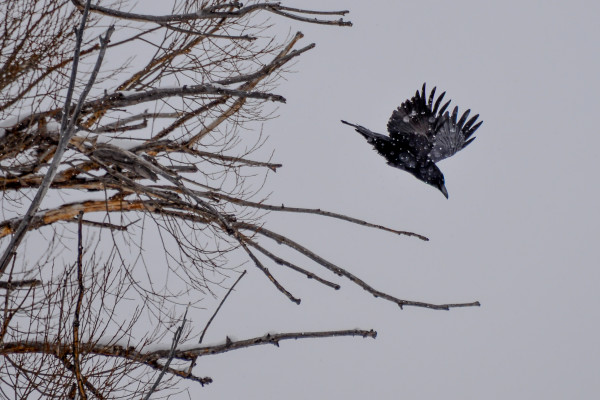Birding While Hunting

by David Cronenwett
The big game season is now winding down in Montana. I came home this year with a small buck early in the day, my first day afield, which was a major stroke of good fortune. Anyone who hunts understands that it usually requires a lot of focus, patience and luck to be successful. In the long hours of stalking and waiting for prey to appear, the hunter experiences a state of greatly heightened awareness, noticing small details of animal sign, smells, anything unusual or out of place on the land. At least, that’s how it is for me.
The visceral sense of being an active player in the web of life (rather than simply an observer), is one of the more important, compelling reasons given when people explain why they hunt. For some individuals though, there is an unresolvable conflict between pursing and killing prey on the one hand, and simply enjoying the presence of wildlife on the other. I respect each view and it should be remembered that the conservation movement in North America, an incredible success story by any measure, was initiated by both hunting and birding organizations.
I don’t know why exactly, but I’ve had some of my most interesting and memorable observations of bird behavior while out hunting. Maybe because, when in that “hunter’s mind,” everything seems more luminous and meaningful. On one snowy, below-zero morning I painstakingly stalked through a cottonwood forest. Deer and elk trails fanned out before me, heading into thickets and across open meadows of the floodplain. It was incredibly quiet. The foot or so of powder and punishing cold crystallized the world into a silent, grayscale landscape. While paused near some brush, a great horned owl appeared out of nowhere and landed ten feet up in the crook of a nearby cottonwood. In its talons, was a large and freshly killed sharp-tailed grouse.
That owl looked right into me with wild eyes, then immediately began tearing into his prey, which I took as a kind of acceptance of my presence. I was startled by this unexpected moment of unity between two hunters whose lives, though separated by profound differences, briefly intersected amidst woods, river and snow. Experiences like these could scarcely be imagined if they didn’t actually happen once in a while.
Another notable interaction occurred while hunting whitetails in an area with a very active grizzly population. After several minutes of stalking through dense brush, I emerged into a small meadow. I was groggy that morning and had been looking down at deer tracks, practically sleepwalking, when a raucous gaggle of magpies quickly brought me to my senses. They were joyfully scavenging on a lion-killed carcass thirty yards away. I’d likely have stumbled much closer to the animal remains in the morning twilight, had I not been warned by the birds. With high potential for big, toothy beasts nearby, I immediately turned tail and booked it out of there, grateful for the heads up.
Birds can also enhance the hunting experience in other ways. There are credible stories both ancient and contemporary of corvids, especially ravens, following human hunters in the hope of benefitting from the remains of a kill. It has also been reported by some northern Native cultures that ravens will occasionally signal the presence of a nearby animal to a hunter for the same reason. Given the extraordinary intelligence of these birds, it might not be a bad idea to pay particularly close attention to ravens while big game hunting.
For many hunters, the long hours of stalking and sitting are made far more interesting by the presence of Montana’s native birds. Not all hunters consider themselves birders nor are all birders necessarily hunters, but both groups share a deep love of wildlife and often support similar conservation goals. The closely intertwined histories of hunters and bird enthusiasts (namely The Audubon Society and the Boone & Crockett Club) that began in the late nineteenth and early twentieth centuries, set the stage for the remarkable conservation legacy we have in the United States today. Of course, much work remains to be done. I expect those closest to the wildlife, whether armed with binoculars or guns (or both), will accomplish a great deal of this important work in the future.